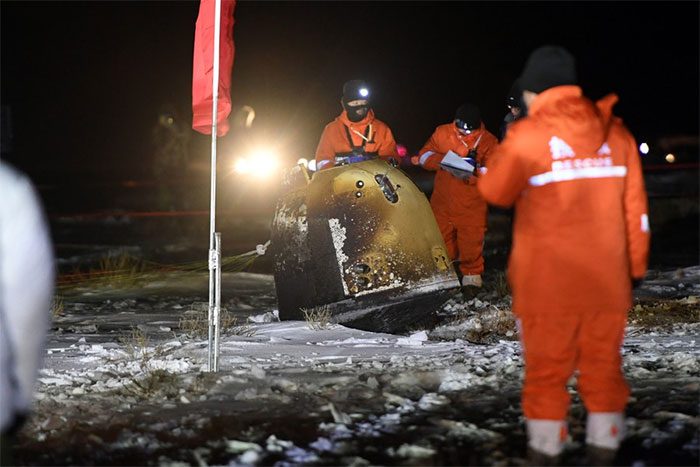A team of Chinese scientists has analyzed rock samples collected by the Chang’e 5 lunar probe from the Moon.
Previously, scientists speculated that high water content or radioactive elements within the Moon may have driven volcanic activity during the later stages of the Moon’s life. However, data collected by the Chang’e 5 probe indicates that the outer covering is both dry and lacking in heat-producing materials.

The Chang’e 5 probe landed in the Inner Mongolia Autonomous Region, northern China, completing its lunar exploration mission on December 17, 2020. (Photo: THX/TTXVN)
A study published in the journal Science Advances on October 22 revealed that the molten hotspots on the surface layer, due to melting or easily meltable components, could lead to the formation of lunar volcanoes.
Researchers from the Institute of Geology and Geophysics at the Chinese Academy of Sciences (IGGCAS) meticulously examined 27 basalt rock samples brought back by the Chang’e 5 from the Moon to calculate their original components. They discovered that the magma in the samples returned by Chang’e 5 may contain higher levels of calcium oxide and titanium dioxide compared to the magma found in samples collected by the Apollo missions of the United States.
The Chang’e 5 probe has demonstrated the activity of 2 billion-year-old volcanoes, thereby ruling out the hypothesis that the Moon has been “geologically dead” since the collection of samples from at least 3 billion years ago by Apollo.
The research indicates that the late-stage lunar magma ocean accumulated in the samples brought back by Chang’e 5 is rich in calcium and titanium, and melts more easily. Scientists suggest that these melting components inside the Moon may lower the melting temperature of the surface layer, thus triggering the formation of lunar volcanoes.
Scientist Su Bin from IGGCAS stated: “We found that the magma brought back by Chang’e 5 was produced at a similar depth but was 80 degrees Celsius cooler than the magma collected by Apollo. This means that the Moon’s crust has undergone a ‘cooling’ period of 80 degrees Celsius from about 3 billion to 2 billion years ago.”
According to scientists, this research based on samples returned by the Chang’e 5 provides evidence for a plausible mechanism explaining volcanic formation on the Moon.
The lunar rock samples collected by the Apollo (USA) and Luna (Russia) missions decades ago have provided insights into the history and evolution of the Moon. However, the sampling locations were all situated in low-latitude regions, thus failing to represent the most common surface characteristics of the celestial body.
The Chang’e 5 mission is expected to fill this gap, being the first mission in history to collect rock samples from the Moon’s mid-latitude region—a dark and flat area known as the “Ocean of Storms”. Scientists believe this region is likely to contain evidence of the earliest volcanic activity on the Moon.


















































